Dealing with drain flies can be a real headache for many families in India. These tiny insects love to live in our drains’ wet and dirty parts, making our homes feel less clean and peaceful. In a country like ours, with its hot and humid weather, these flies find the perfect place to grow and become even more of a problem.
It’s not just about the annoying buzzing around; it’s also about keeping our homes healthy and free from pests. Learning how to get rid of drain flies is important for everyone wanting to keep their living spaces comfortable and hygienic.
In this blog, we will share six simple and effective tips to help you get rid of drain flies for good. These tips are especially useful for helping you to maintain a clean and happy home without too much fuss.
How to Get Rid of Drain Flies: Identify Them
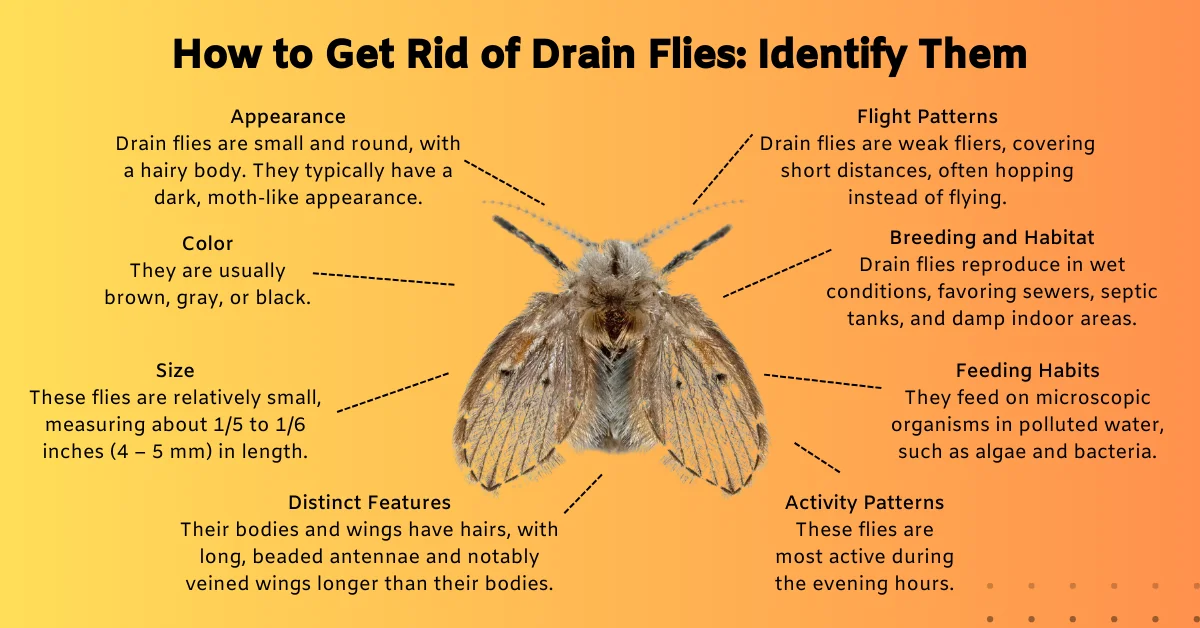
When figuring out how to get rid of drain flies, also known as moth or sink flies, it’s crucial to recognize their unique traits. These pests thrive in damp spots, especially around kitchen and bathroom drains. They’re drawn to standing water and the organic matter that accumulates in drains, which makes these areas hotspots for drain fly infestations.
Key characteristics to identify drain flies:
- Appearance: Drain flies are small and round, with a hairy body. They typically have a dark, moth-like appearance.
- Color: They are usually brown, gray, or black.
- Size: These flies are relatively small, measuring about 1/5 to 1/6 inches (4 – 5 mm) in length.
- Distinct Features: Their bodies and wings are covered in hair, and they have long, beaded antennae. The wings are often longer than their bodies and show noticeable veins.
- Flight Patterns: Drain flies are weak fliers. They tend to cover only short distances with each flight or jump, often appearing to hop rather than fly.
- Breeding and Habitat: Drain flies lay their eggs in batches, typically in standing water or very moist environments. They are commonly found in sewers, septic tanks, clogged gutters, and humid areas like bathrooms and basements.
- Feeding Habits: They feed on microscopic organisms in polluted water, such as algae and bacteria.
- Activity Patterns: These flies are most active during the evening hours.
Although drain flies do not pose a significant health risk as they do not bite humans or pets, they can be a nuisance and may trigger asthma in some individuals. Their presence often indicates a need for better sanitation and control of moist environments in affected areas.
How to Get Rid of Drain Flies: 6 Best Tips
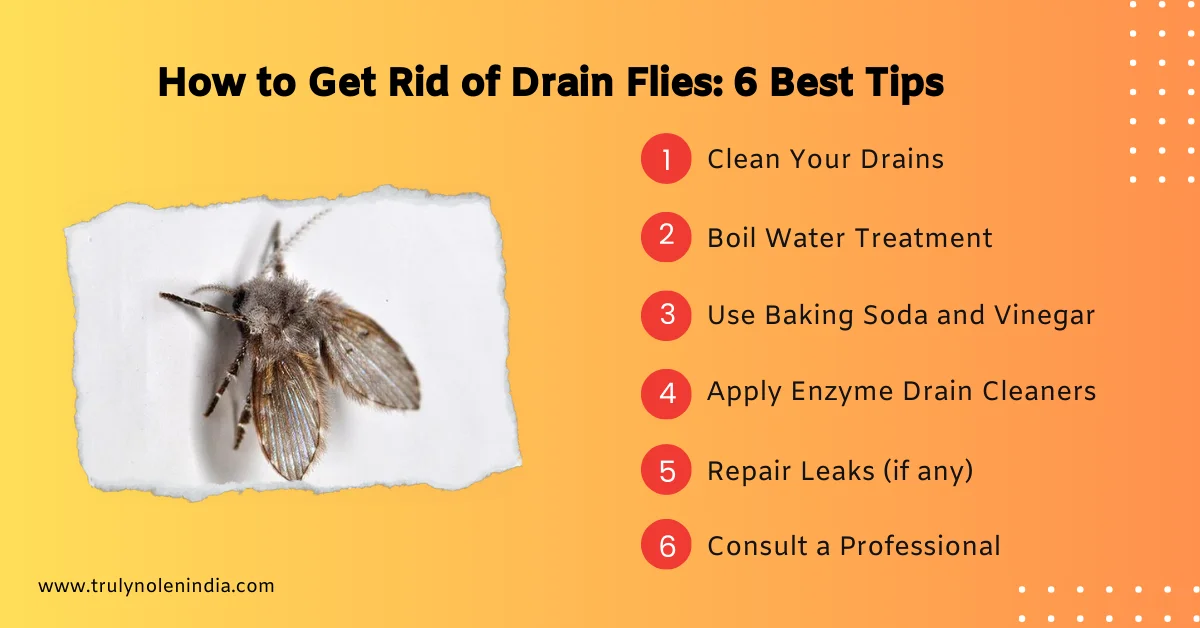
In this section, we’ll dive into the best tips on how to get rid of drain flies, a common nuisance in many households. These tiny pests, thriving in moist environments, can quickly become a significant problem if not addressed properly. Whether you’re dealing with a current infestation or looking to prevent one, our expert advice will guide you through effective strategies to keep your home safe from drain flies.
Tip 1: Clean Your Drains
To effectively remove drain flies, start by manually cleaning your drains. This involves physically removing any visible organic matter, a primary breeding ground for these flies. Use a sturdy metal pipe brush to scrub the sides of your drain pipe rigorously. This action helps dislodge and remove the organic buildup where drain flies lay their eggs.
For more challenging clogs, you might find a plunger to be a useful tool. It’s important to focus on areas within the drain where organic material, such as food scraps or grease, tends to accumulate, as these are the hotspots for drain fly activity. Regularly cleaning these areas can significantly reduce the likelihood of drain fly infestations.
Best Practices to Keep Your Drains Clean Always
- Use Drain Strainers: Install strainers in your sinks and showers to catch hair, food particles, and other debris. Clean these strainers regularly.
- Dispose of Grease Properly: Never pour grease or oil down the drain. Instead, let it cool and dispose of it in the trash. Grease solidifies in your pipes and can cause severe blockages.
- Avoid Chemical Drain Cleaners: Harsh chemical cleaners can damage your plumbing over time. They are also not environmentally friendly and can be hazardous to your health.
Tip 2: Boil Water Treatment
Start by boiling a substantial amount of water, ensuring enough to cover the entire length of your drain pipes effectively. Make it a routine to pour the boiling water down the affected drains twice daily, once in the morning and again in the evening, for one week.
Before starting the boiling water treatment, it’s beneficial to physically clean the drains using a pipe brush to remove any visible debris or build-up, enhancing the effectiveness of the hot water treatment.
If your home features non-metal pipes such as PVC, it’s important to exercise caution. In these cases, using hot but not boiling water is advisable to avoid potential damage to the pipes. In some instances, especially with severe infestations, you might find that a single week of treatment is not sufficient.
If drain flies are still present after the first week, consider repeating the process for another week. Always prioritize safety when handling boiling water. Use a suitable container for handling high temperatures and carefully pour the water to prevent splashes and burns.
Tip 3: Use Baking Soda and Vinegar
Begin by measuring out half a cup of baking soda and half a cup of vinegar. This combination creates a fizzing reaction that helps to break down organic material in the drain. Carefully pour the baking soda directly into the drain, followed by the vinegar. This order is important for ensuring the reaction occurs right in the drain where it’s needed.
Once you’ve added the vinegar, you’ll notice a fizzing action. This is the mixture working to break down the gunk in the drain. Cover the drain immediately after pouring the vinegar. This helps keep the reaction within the drain, maximizing its effectiveness.
Allow this mixture to sit and work in the drain for about an hour. During this time, the baking soda and vinegar work together to dissolve and loosen the organic matter. After the hour is up, flush the drain with warm water. This helps to wash away the loosened debris and any remaining mixture. To keep drain flies at bay, repeat this process weekly. Regular maintenance with this method can help prevent the accumulation of organic matter that attracts drain flies.
Tip 4: Apply Enzyme Drain Cleaners
Enzyme-based cleaners naturally break down organic matter that accumulates in your drains, such as grease, hair, and food residues. This organic matter serves as a food source and breeding ground for drain flies. Unlike harsh chemical cleaners, enzyme cleaners do not damage your plumbing or the environment. They are a safe option for regular use in all types of drains.
When using enzyme cleaners, follow the instructions carefully. Usually, you’ll need to pour the recommended amount into the drain and leave it to work for a specified period, often overnight. These cleaners use beneficial bacteria that consume the organic material in the drains. As a result, they not only clear current blockages but also help prevent future build-ups.
Use enzyme drain cleaners regularly as part of your routine drain maintenance for best results. This will keep your drains clear and reduce the likelihood of drain flies returning.
Consider these if you are using enzyme cleaners regularly:
- Slower Action: Enzyme cleaners work more slowly compared to chemical cleaners. They’re better suited for regular maintenance rather than urgent clog removal.
- Not for Severe Clogs: Mechanical methods or professional plumbing services might still be necessary for tough blockages.
- Safety Precautions: While generally safe, avoid direct contact with skin or eyes to prevent irritation.
- Regular Use for Effectiveness: Consistent and regular use is key to maintaining clear drains with enzyme cleaners.
- Eco-Friendly and Pipe-Safe: These cleaners are non-corrosive and safe for the environment, making them ideal for older pipes and septic systems.
- Check Cleaner Compatibility: Ensure the enzyme cleaner is suitable for your plumbing and septic system type, if applicable.
Tip 5: Repair Leaks (if any)
Repairing leaks is essential when dealing with drain flies because these pests thrive in moist environments. Drain flies, also known as sink flies or sewer gnats, breed in stagnant water, often found in drains and pipes with minor leaks. These leaks create the perfect habitat for drain flies to lay their eggs, leading to an infestation.
By fixing leaks, you eliminate the moist conditions that attract drain flies. This not only helps in controlling their current population but also prevents future infestations. In addition to repairing leaks, regular cleaning of drains and ensuring they are free from organic material and standing water is crucial in keeping these pests at bay.
Ignoring leaks can lead to a persistent problem with drain flies, as they can quickly multiply in favorable conditions. Therefore, promptly addressing leaks is key to effective pest control and maintaining a healthy and hygienic environment.
Tip 6: Consult a Professional
If you’ve tried all the previous steps and are still struggling with a persistent drain fly infestation, it may be time to consult a professional like Truly Pest Solution. Pest control experts or experienced plumbers can offer specialized solutions tailored to your situation.
Professionals can access tools and methods not typically available to the average homeowner. For instance, a plumber might use a camera to inspect the pipes and identify hidden issues, such as deep clogs or structural problems, that could be contributing to the infestation. Pest control experts, on the other hand, can apply treatments that are more effective and long-lasting than over-the-counter options.
When selecting a professional, look for someone with experience dealing with drain flies. Check their credentials and read reviews to ensure they are reputable and effective. A good professional will help eliminate the current problem and advise on preventing future infestations.
Remember, while it might cost more to hire a professional, their expertise can save you time and hassle in the long run. They can help ensure your drain fly problem is completely resolved, allowing you to maintain a clean and healthy home environment.
While focusing on how to get rid of drain flies with our six expert tips, it’s also crucial to consider the broader context of pest control within your home. Drain flies are just one of many pests that can invade your living spaces, leading to discomfort and potential health risks. For those dealing with a variety of pest issues, including termites, cockroaches, bed bugs, and flies, understanding the effectiveness of pest control measures is essential.
Read our related blog, How Effective Is Pest Control For Termites, Cockroaches, Bed Bugs And Flies: An Overview, and explore comprehensive strategies and solutions for managing these common pests.
Say Goodbye to Flies with Truly Pest Solution
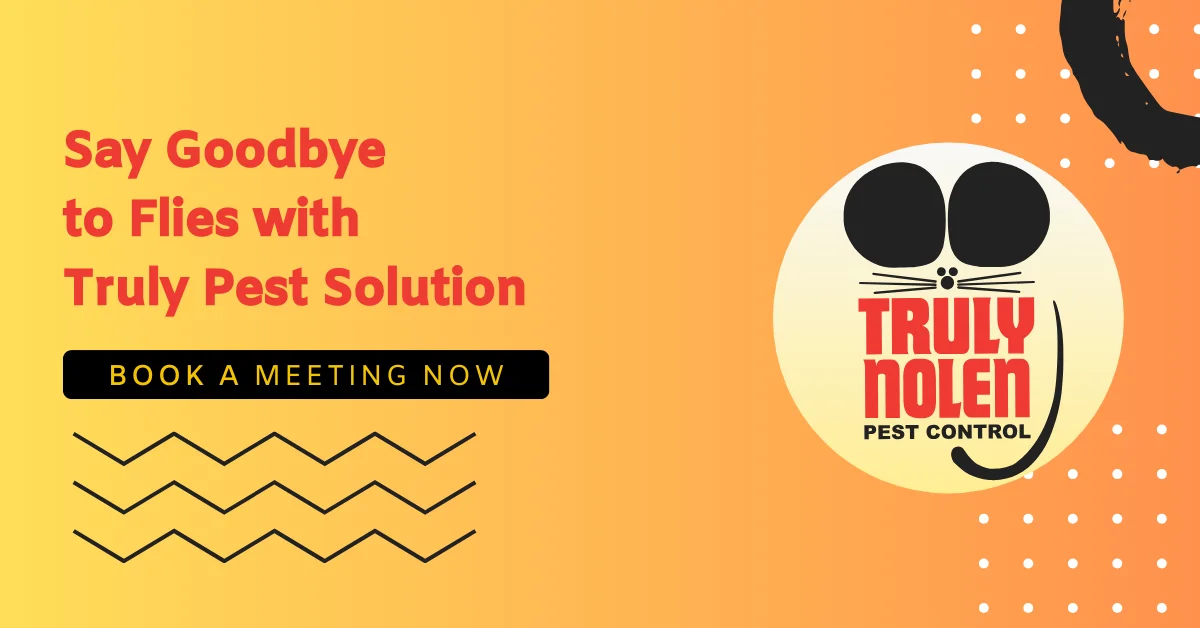
At Truly Pest Solution, we recognize the distinct challenges that flies present in both residential and commercial settings. To address this, we’ve developed the Truly Elite Protection System (TEPS) and the Intelligent Fly Control Service (IFCS).
These innovative approaches surpass conventional pest control tactics, rooted in our commitment to Integrated Pest Management (IPM) principles. This ensures a thorough and lasting solution for fly prevention. We focus on controlling and minimizing fly infestations in your spaces.
Don’t let flies compromise your cleanliness and peace of mind!
Contact Truly Pest Solution and book a free inspection!
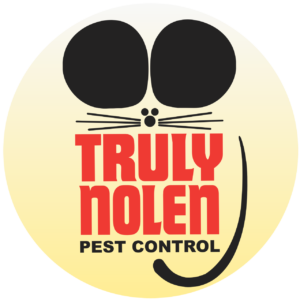
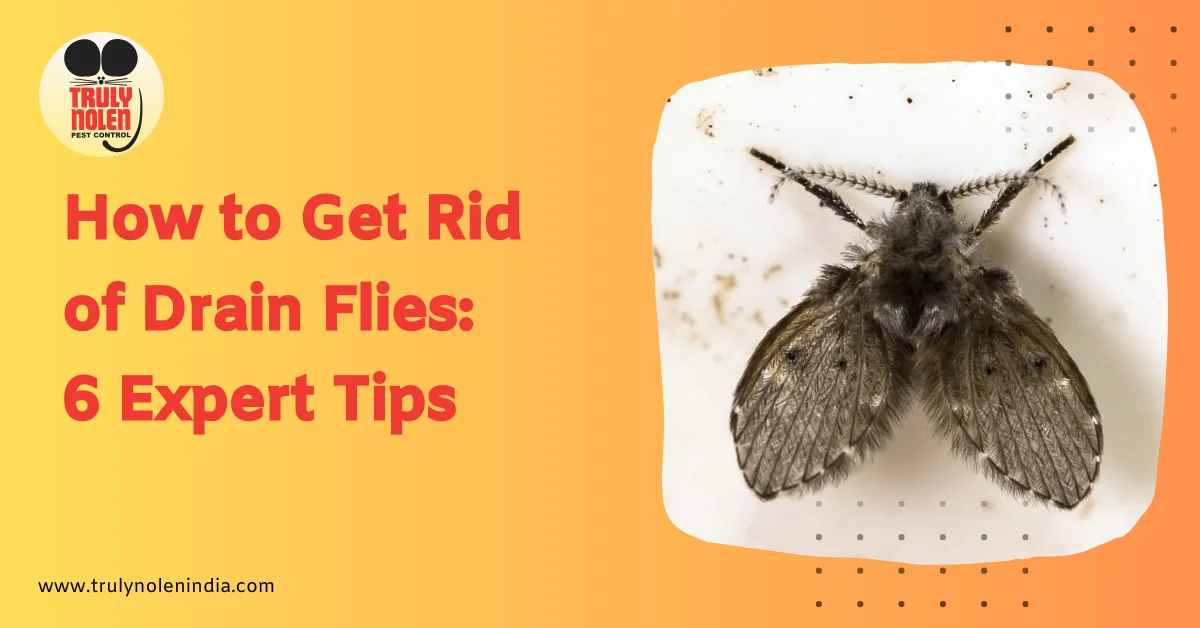
Leave a Reply